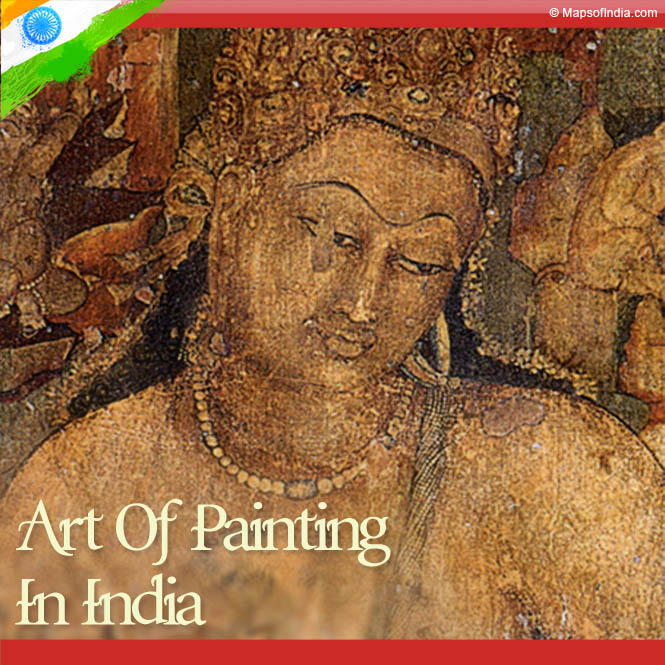
Each form of art is associated with a distinct historical period and thus art has an illustrious journey in India. Though regional, geographical and cultural differences are obvious in any art, every Indian art style has a remarkable unity in it still. Not only classical paintings, but the traditional art and paintings created in various rural areas of India prove the same.
Ancient Indian art used to revolve around daily life and this was the most significant feature of art at that time. The main characteristic was to depict peace and tranquility. Often Indian art is classified as religious art but it is not true and applicable to all art forms. Though images of idols are an integral part but then also these were inspired by life. Through art of painting celebrations of life, human aspirations and concerns were depicted clearly.
In pre-historic era came the earliest known rock paintings. Some of the paintings were even from the time before 5500 BC found in places like Bhimbetka. Then came the popular carved paintings such as those found in the Ajanta caves. Paintings in the Mughal period combined the Persian and old Indian traditional art. Under British rule came the style of company paintings that were especially made for British clients. Post-Independence era is the period of modern paintings in which the traditional Indian paintings were again brought back with changes.
Story of Indian Painting
Murals and miniatures are the two basic forms of Indian painting. Murals are the large piece of art done on the walls whereas miniature paintings are the small paintings done for books or albums. Miniature paintings were started by the Palas of Bengal and enhanced by Rajasthani schools such as Jaipur, Mewar, Bundi, etc. Mural paintings dated back to 2nd century BC to between 8th and 10th century AD covering the ancient and early medieval period. Most of the mural paintings are based on religious themes.
Mughal paintings
Mughal paintings (16th-19th century) added a new style to Indian painting. To make these paintings, Indian, Persian and Islamic style was blended. Akbar, a renowned Mughal ruler had a great inclination towards art. Under his guidance a new school of painting had emerged in India that was known as the Mughal School of Miniature Paintings. For this purpose more than hundred painters from Gwalior, Kashmir and Gujarat were hired. They created the Hamzanama series in the form of miniature painting. To make this, very brilliant colors like red, blue and green were used. Close to the end, more Indian touch can be seen as more Indian artists were hired to complete the task.
After Akbar, Jahangir, another Mughal ruler enhanced the art and painting through portraits and durbar scenes. To create these very talented portrait painters Ustad Mansur, Abul Hasan and Bishandas were hired. The art was also carried forwarded by Shah Jahan.
Rajput painting
Rajput painting is an Indian painting style that had emerged during the 18th century. Though each Rajput kingdom had its own style, most of these paintings had some common feature. Various themes like events from the great epics the Ramayana and the Mahabharata along with human life were the main subject line of these paintings. Colors used in the creation of Rajput paintings were extracted from minerals, plants, conch shells and even from the precious stones, gold and silver.
Mysore painting
This painting style originated in south India in Mysore. Based on Hindu mythology, Mysore paintings had a unique style and known for their detail and elegance.
Tanjore painting
Originating in Tanjore, Tamil Nadu, this art form is very ancient and dates back to the early 9th century. Tanjore paintings were encouraged by Chola rulers who had unwavering love for art and culture. Pure gold and precious stones are used for the decoration purposes thus making these paintings expensive.
Pattachitra
Folk painting of Odisha is known as Pattachitra. Patta in Sanskrit means ‘clothing’ and chitra means ‘painting’. Traditionally Pattachitra is linked to the Lord Jagannath. This painting style is also found in the caves of Khandagiri and Udayagiri and even in the Sitabhinji murals that belonged to 6th century AD.
Madhubani painting
It is a popular painting style in Mithila region of Bihar. Mythological scenes are the base of this painting style but not confined to the same. Some of the Madhubani paintings are also made using themes such as social events and scenes from the royal court. The painting covers the entire space and filled with geometric patterns. Generally, a solid color is used that is made from herbs and flowers.
Modern Indian painting
Indian art was greatly influenced by the Western culture and art form during colonial rule. Western style was adopted to depict Indian themes. But many new forms and ideas of modern painting style emerged in the post-Independence era. Art galleries were formed for showcasing the work. Efforts were made to revive the traditional Indian art form along with new art style. Now, the International art market has many well established names of Indian artists. Even the Indian art galleries in Western countries showcase our art and culture.




